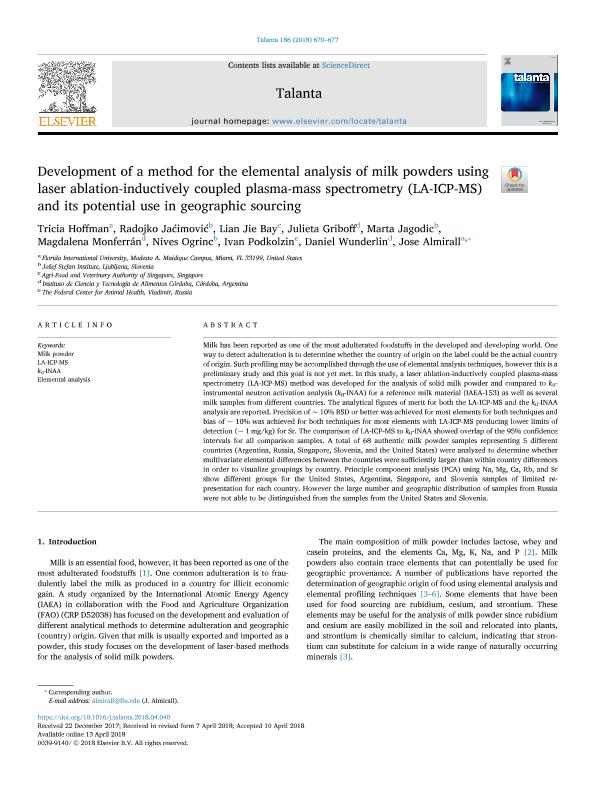Mostrar el registro sencillo del ítem
dc.contributor.author
Hoffman, Tricia
dc.contributor.author
Jaćimović, Radojko
dc.contributor.author
Bay, Lian Jie
dc.contributor.author
Griboff, Julieta

dc.contributor.author
Jagodic, Marta
dc.contributor.author
Monferran, Magdalena Victoria

dc.contributor.author
Ogrinc, Nives
dc.contributor.author
Podkolzin, Ivan
dc.contributor.author
Wunderlin, Daniel Alberto

dc.contributor.author
Almirall, Jose
dc.date.available
2019-11-12T17:51:15Z
dc.date.issued
2018-08
dc.identifier.citation
Hoffman, Tricia; Jaćimović, Radojko; Bay, Lian Jie; Griboff, Julieta; Jagodic, Marta; et al.; Development of a method for the elemental analysis of milk powders using laser ablation-inductively coupled plasma-mass spectrometry (LA-ICP-MS) and its potential use in geographic sourcing; Elsevier Science; Talanta; 186; 8-2018; 670-677
dc.identifier.issn
0039-9140
dc.identifier.uri
http://hdl.handle.net/11336/88653
dc.description.abstract
Milk has been reported as one of the most adulterated foodstuffs in the developed and developing world. One way to detect adulteration is to determine whether the country of origin on the label could be the actual country of origin. Such profiling may be accomplished through the use of elemental analysis techniques, however this is a preliminary study and this goal is not yet met. In this study, a laser ablation-inductively coupled plasma-mass spectrometry (LA-ICP-MS) method was developed for the analysis of solid milk powder and compared to k0-instrumental neutron activation analysis (k0-INAA) for a reference milk material (IAEA-153) as well as several milk samples from different countries. The analytical figures of merit for both the LA-ICP-MS and the k0-INAA analysis are reported. Precision of ~ 10% RSD or better was achieved for most elements for both techniques and bias of ~ 10% was achieved for both techniques for most elements with LA-ICP-MS producing lower limits of detection (~ 1 mg/kg) for Sr. The comparison of LA-ICP-MS to k0-INAA showed overlap of the 95% confidence intervals for all comparison samples. A total of 68 authentic milk powder samples representing 5 different countries (Argentina, Russia, Singapore, Slovenia, and the United States) were analyzed to determine whether multivariate elemental differences between the countries were sufficiently larger than within country differences in order to visualize groupings by country. Principle component analysis (PCA) using Na, Mg, Ca, Rb, and Sr show different groups for the United States, Argentina, Singapore, and Slovenia samples of limited representation for each country. However the large number and geographic distribution of samples from Russia were not able to be distinguished from the samples from the United States and Slovenia.
dc.format
application/pdf
dc.language.iso
eng
dc.publisher
Elsevier Science

dc.rights
info:eu-repo/semantics/openAccess
dc.rights.uri
https://creativecommons.org/licenses/by-nc-sa/2.5/ar/
dc.subject
ELEMENTAL ANALYSIS
dc.subject
K0-INAA
dc.subject
LA-ICP-MS
dc.subject
MILK POWDER
dc.subject.classification
Química Analítica

dc.subject.classification
Ciencias Químicas

dc.subject.classification
CIENCIAS NATURALES Y EXACTAS

dc.title
Development of a method for the elemental analysis of milk powders using laser ablation-inductively coupled plasma-mass spectrometry (LA-ICP-MS) and its potential use in geographic sourcing
dc.type
info:eu-repo/semantics/article
dc.type
info:ar-repo/semantics/artículo
dc.type
info:eu-repo/semantics/publishedVersion
dc.date.updated
2019-10-15T15:18:38Z
dc.journal.volume
186
dc.journal.pagination
670-677
dc.journal.pais
Países Bajos

dc.journal.ciudad
Amsterdam
dc.description.fil
Fil: Hoffman, Tricia. Florida International University; Estados Unidos
dc.description.fil
Fil: Jaćimović, Radojko. Joef Stefan Institute; Eslovenia
dc.description.fil
Fil: Bay, Lian Jie. Agri-food And Veterinary Authority; Singapur
dc.description.fil
Fil: Griboff, Julieta. Consejo Nacional de Investigaciones Científicas y Técnicas. Centro Científico Tecnológico Conicet - Córdoba. Instituto de Ciencia y Tecnología de Alimentos Córdoba. Universidad Nacional de Córdoba. Facultad de Ciencias Químicas. Instituto de Ciencia y Tecnología de Alimentos Córdoba; Argentina
dc.description.fil
Fil: Jagodic, Marta. Joef Stefan Institute; Eslovenia
dc.description.fil
Fil: Monferran, Magdalena Victoria. Consejo Nacional de Investigaciones Científicas y Técnicas. Centro Científico Tecnológico Conicet - Córdoba. Instituto de Ciencia y Tecnología de Alimentos Córdoba. Universidad Nacional de Córdoba. Facultad de Ciencias Químicas. Instituto de Ciencia y Tecnología de Alimentos Córdoba; Argentina
dc.description.fil
Fil: Ogrinc, Nives. Joef Stefan Institute; Eslovenia
dc.description.fil
Fil: Podkolzin, Ivan. The Federal Center For Animal Health; Rusia
dc.description.fil
Fil: Wunderlin, Daniel Alberto. Consejo Nacional de Investigaciones Científicas y Técnicas. Centro Científico Tecnológico Conicet - Córdoba. Instituto de Ciencia y Tecnología de Alimentos Córdoba. Universidad Nacional de Córdoba. Facultad de Ciencias Químicas. Instituto de Ciencia y Tecnología de Alimentos Córdoba; Argentina
dc.description.fil
Fil: Almirall, Jose. Florida International University; Estados Unidos
dc.journal.title
Talanta

dc.relation.alternativeid
info:eu-repo/semantics/altIdentifier/url/https://www.sciencedirect.com/science/article/pii/S0039914018303965
dc.relation.alternativeid
info:eu-repo/semantics/altIdentifier/doi/https://doi.org/10.1016/j.talanta.2018.04.040
Archivos asociados
